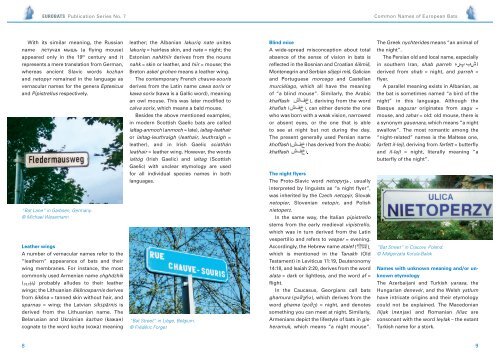FSCcertified
EUROBATS-Publication%20Series%20No.7_web
EUROBATS-Publication%20Series%20No.7_web
Create successful ePaper yourself
Turn your PDF publications into a flip-book with our unique Google optimized e-Paper software.
EUROBATS Publication Series No. 7<br />
Common Names of European Bats<br />
With its similar meaning, the Russian<br />
leather; the Albanian lakuriq nate unites<br />
Blind mice<br />
The Greek nychterides means “an animal of<br />
name летучая мышь (a flying mouse)<br />
lakuriq = hairless skin, and nate = night; the<br />
A wide-spread misconception about total<br />
the night”.<br />
appeared only in the 19 th<br />
century and it<br />
Estonian nahkhiir derives from the nouns<br />
absence of the sense of vision in bats is<br />
The Persian old and local name, especially<br />
represents a mere translation from German,<br />
nahk = skin or leather, and hiir = mouse; the<br />
reflected in the Bosnian and Croatian šišmiš,<br />
in southern Iran, shab parreh ( )<br />
whereas ancient Slavic words<br />
kozhan<br />
Breton askel grohen means a leather wing.<br />
Montenegrin and Serbian slijepi miš, Galician<br />
derived from shab = night, and parreh =<br />
and netopyr remained in the language as<br />
The contemporary French chauve-souris<br />
and Portuguese morcego and Castellan<br />
flyer.<br />
vernacular names for the genera Eptesicus<br />
derives from the Latin name cawa sorix or<br />
murciélago, which all have the meaning<br />
A parallel meaning exists in Albanian, as<br />
and Pipistrellus respectively.<br />
kawa sorix (kawa is a Gallic word), meaning<br />
of “a blind mouse”. Similarly, the Arabic<br />
the bat is sometimes named “a bird of the<br />
an owl mouse. This was later modified to<br />
khaffash (<br />
), deriving from the word<br />
night” in this language. Although the<br />
calva sorix, which means a bald mouse.<br />
khafish (<br />
), can either denote the one<br />
Basque saguzar originates from sagu =<br />
Besides the above mentioned examples,<br />
who was born with a weak vision, narrowed<br />
mouse, and zahar = old: old mouse, there is<br />
in modern Scottish Gaelic bats are called<br />
or absent eyes, or the one that is able<br />
a synonym gauenara, which means “a night<br />
ialtag-anmoch (anmoch = late), ialtag-leathair<br />
to see at night but not during the day.<br />
swallow”. The most romantic among the<br />
or ialtag-leuthraigh (leathair, leuthraigh =<br />
The present generally used Persian name<br />
“night-related” names is the Maltese one,<br />
leather), and in Irish Gaelic sciathán<br />
khoffash ( ) has derived from the Arabic<br />
farfett il-lejl, deriving from farfett = butterfly<br />
leathair = leather wing. However, the words<br />
khaffash ( ).<br />
and il-lejl = night, literally meaning “a<br />
ialtóg (Irish Gaelic) and ialtag (Scottish<br />
butterfly of the night”.<br />
Gaelic) with unclear etymology are used<br />
for all individual species names in both<br />
The night flyers<br />
languages.<br />
The Proto-Slavic word netopyrjь , usually<br />
interpreted by linguists as “a night flyer”,<br />
was inherited by the Czech netopýr, Slovak<br />
netopier, Slovenian netopir, and Polish<br />
“Bat Lane” in Garbsen, Germany.<br />
© Michael Wesemann<br />
nietoperz.<br />
In the same way, the Italian pipistrello<br />
stems from the early medieval vipistrello,<br />
which was in turn derived from the Latin<br />
vespertilio and refers to vesper = evening.<br />
Leather wings<br />
A number of vernacular names refer to the<br />
Accordingly, the Hebrew name atalef ( ),<br />
which is mentioned in the Tanakh (Old<br />
“Bat Street” in Cracow, Poland.<br />
© Małgorzata Kotula-Balak<br />
“leathern” appearance of bats and their<br />
Testament) in Leviticus 11:19, Deuteronomy<br />
wing membranes. For instance, the most<br />
14:18, and Isaiah 2:20, derives from the word<br />
Names with unknown meaning and/or un-<br />
commonly used Armenian name chghdzhik<br />
alata = dark or lightless, and the word af =<br />
known etymology<br />
() probably alludes to their leather<br />
flight.<br />
The Azerbaijani and Turkish yarasa, the<br />
wings; the Lithuanian šikšnosparnis derives<br />
In the Caucasus, Georgians call bats<br />
Hungarian denevér, and the Welsh ystlum<br />
from šikšna = tanned skin without hair, and<br />
ghamura (ღამურა), which derives from the<br />
have intricate origins and their etymology<br />
sparnas = wing; the Latvian sikspārnis is<br />
word ghame (ღამე) = night, and denotes<br />
could not be explained. The Macedonian<br />
derived from the Lithuanian name. The<br />
something you can meet at night. Similarly,<br />
liljak (лилјак) and Romanian liliac are<br />
Belarusian and Ukrainian kazhan (kaжaн)<br />
cognate to the word kozha (кожа) meaning<br />
“Bat Street” in Liège, Belgium.<br />
© Frédéric Forget<br />
Armenians depict the lifestyle of bats in gisheramuk,<br />
which means “a night mouse”.<br />
consonant with the word leylak – the extant<br />
Turkish name for a stork.<br />
8<br />
9


